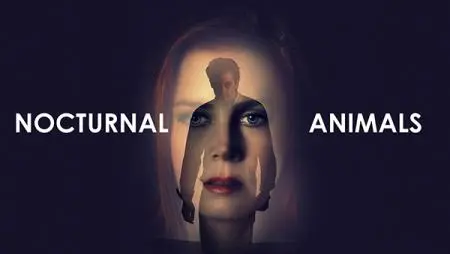Nocturnal Animals, released in 2016, took a classic horror movie trope and added prestige to it. That is, the idea that traveling on rural highways, especially at night, will result in an encounter with lunatics and death. This has existed at least as far back as 1974’s The Texas Chain Saw Massacre, with its band of five teens picking up a hitchhiker which turns out to be a catalyst for a night of brutal violence and madness. Then there’s 1986’s The Hitcher, in which C. Thomas Howell plays a game of cat and mouse with serial killer Rutger Hauer on the lonely stretches of desert road in West Texas. And the list goes on, from Kalifornia to Joy Ride to Wolf Creek: don’t stray far from from major interstates. Pilgrims shouldn’t go into the woods, because that’s where the savages prowl the night.
But this didn’t originate in the movies, and more than likely can be traced back to a short story by Flannery O’Connor called “A Good Man is Hard to Find.” A Southern writer and essayist, she often wrote in the Southern Gothic style, focusing on flawed, disturbed or idiosyncratic characters who may or may not be supernatural, androgynous, live in decrepit settings or are involved in sinister happenings related to crime and poverty. Another good example of the Southern Gothic style would be William Faulkner’s “A Rose for Emily.”
O’Connor relied heavily on regional settings and grotesque characters. Her stories reflect a Roman Catholic background, with stories examining morality and ethics from a strict Old Testament perspective with cynicism, anger and little flexibility. “A Good Man is Hard to Find” in particular passes a swift and harsh judgment upon its characters in a way that may seem unfair, much like how Jake Gyllenhaal’s character in Nocturnal Animals subjects the characters of his book to an unfortunate ending. But the problem with the latter is it reveals a marginalization of women in these kinds of stories, something that has perverted the point of O’Connor’s original intention.
“A Good Man is Hard to Find” was published in 1953 and is O’Connor’s best-known work. In the years since its publication it has become a fixture in higher level college literature courses, mostly because of its controversial ending. The story follows a family on a trip from Atlanta to Florida on their summer vacation. The father, Bailey, has brought his wife (who goes unnamed) and mother (who is referred to as Grandmother) along, as well his young children John Wesley, June Star, and an unnamed male baby. Bailey and the Grandmother are the main characters, with the latter wanting the family to drive to East Tennessee, where she grew up, instead. All the while it’s mentioned that an escaped serial killer, known only as The Misfit, was last seen in Florida.
The story is fairly simplistic and episodic. The Grandmother talks constantly and tries to engage the children in conversation and games, but they’re turned off by her, as is Bailey. Grandmother complains about how things were so much better when she was growing up in the Deep South, and this continues when they stop at a diner for lunch. Here a big chunk of the story is devoted to a conversation with the owner, Red Sammy Butts, and his wife about The Misfit and all agree how bad things have gotten. After they get back on the road, the Grandmother coerces the family into turning down a remote dirt road to go visit a house she remembers from her childhood, except she eventually remembers that the house was actually in East Georgia. It’s too late, however, as the car ends up crashing into a ditch, and although they’re relatively unhurt, it's at this point that a deadly trio drives up.

It’s The Misfit and two lackeys, and what ensues has not just led to endless classroom discussion but possibly an entire subgenre of horror movie. The Grandmother recognizes The Misfit, and he implies that if she hadn’t they would have ended up letting the family live. He’s a quiet man in glasses, and they all have guns. In groups the family is taken out into the woods, with gun shots indicating they’ve been executed. The Grandmother, who earlier in the story was very concerned about being considered a “lady” and a Christian, pleads for her life and attempts to reason with The Misfit. She offers him money, then attempts to convince him that he’s a good man, then tries to get him to pray. The Misfit, of course, rejects all of this, lamenting that Jesus should never have raised Lazarus, and that there's “no pleasure but meanness” in life. Tested, the Grandmother mumbles, “Maybe He didn’t raise the dead,” her faith crumbling. In a last-ditch effort she tells The Misfit he’s one of her own children, and he ends up shooting her three times. “She would of been a good woman,” The Misfit declares, “if it had been somebody there to shoot her every minute of her life,” summing up the theme succinctly.
Fast-forward 63 years to 2016 and Nocturnal Animals. Directed by Tom Ford, the American fashion designer turned filmmaker known for his 2009 effort A Single Man. Much like “A Good Man is Hard to Find,” Nocturnal Animals can’t easily be classified within the horror genre. Based on the 1993 novel Tony and Susan by Austin Wright, on the surface it’s a prestige drama, with an emphasis on romance and existential malaise. Not unlike Ford’s previous movie it’s very much a rich-white-people movie, focusing on Amy Adams as Susan Morrow, a Los Angeles art gallery owner who is stuck in a loveless marriage and struggles with not being able to create art herself. This may seem to be of no relation to what can be called the travel or road trip horror that the aforementioned movies picked up from “A Good Man is Hard to Find”, but there are actually multiple layers to the movie.
Edward Sheffield, played by Gyllenhaal, is Susan’s ex-husband who has sent her a manuscript for a novel he’s written and an invitation to dinner during his visit to town. The novel is about a peaceful man, Tony Hastings, who encounters trouble during a road trip through West Texas. Also played by Gyllenhaal, Tony is a stand-in for Edward, with a wife and teenage daughter perhaps functioning as wishful thinking. As they’re driving down a dark, lonely Texas highway they end up getting run off the road by three local hooligans, Ray Marcus (Aaron Taylor-Johnson), Lou Bates (Karl Glusman), and Turk/Steve Adams (Robert Aramayo). The three men end up kidnapping the wife and daughter, with Tony barely escaping. The next day the bodies are found, stripped naked and arm in arm, in the desert. This leads Tony on what appears to be a years-long journey of vengeance.
The problem, and what ties the two levels of reality together, is that Tony is a weak man. When he and a detective, Bobby Andes (Michael Shannon), finally get ahold of the culprits, Tony is hesitant to act. Bobby ends up killing one of them, and when Tony finally corners Ray in a shack, the latter gets the upper hand and hits Tony with a fire poker. Tony is able to shoot Ray, but is blinded from the blow, and ends up dying the next morning when he not only succumbs to a brain hemorrhage but falls on his own gun and shoots himself. The portrayal of the man, almost from beginning to end, is that of pathetic and unmanly individual, a person that can’t defend his family and then can’t even get revenge. This is where Gyllenhaal playing both roles comes in.
In a third layer of the movie, Susan and Edward are in college and have just started dating. Their relationship blossoms, but Susan comes from a rich family and they think the man, who wants to be a writer, won’t ever amount to anything. He even says that she thinks of him as weak at one point, and ultimately she cheats on him with the man that will be her future husband. But the wrinkle is that she’s actually pregnant with Edward’s child, and ends up getting an abortion to ensure that the divorce proceeds forward without complication. Edward finds out, and seemingly the novel is him dealing with that entire experience. Tony’s wife is played by Isla Fisher, a short redhead that bears quite the resemblance to Amy Adams, and presumably the daughter is who he imagines the aborted child might have been. The novel functions as a metaphor for his feelings of impotence and ineptitude that led to the death of his child and dissolving of his marriage.
So it’s telling that author Austin Wright and filmmaker Tom Ford portray Edward as using road trip horror as a way of expressing this metaphor. Horror is, after all, an incredibly potent genre when it comes to communicating social commentary and symbolism. And the elements of road trip horror serve to challenge characters by taking them from a place of comfort, putting them out of their element, and confronting them with threats, namely other human beings, that represent different, harsher approaches to the world.
For instance, in “A Good Man is Hard to Find” the Grandmother’s convictions are put under the magnifying glass. She claims that the world and specifically the United States has soured, and that she represents bygone times. It’s her actions, however, that get her family killed, and when confronted by the Misfit any semblance of faith or grace are thrown out the window.
In Nocturnal Animals’ novel portion, Tony’s masculinity is called into question. He’s unable to defend his wife and daughter from being raped and murdered, with the implicit insult that they’ve been tainted by the sexual assault. That’s perhaps a problematic aspect of the story, both Wright and Ford’s approach to the material, in that in 2016 this feels like a very old-fashioned position. Edward is trying to express his feelings of emasculation at having been cuckolded, but by reducing his fictional wife and daughter into property that can be defiled, the problems that have developed within this subgenre are revealed.
As seen with the likes of The Hills Have Eyes remake, by venturing out into unknown territory, the women specifically are left vulnerable. In that movie and in Nocturnal Animals, a man’s family is violently assaulted, and he has to step up and learn the art of violence in order to win the day. Women are just objects. “A Good Man is Hard to Find,” however, explores the complexities of a woman. She’s deemed to be found wanting, but at least she’s a character and not someone to be avenged.
This subgenre won’t end with Nocturnal Animals, but the movie proves that perhaps its time has passed. Women as victims for lunatics is a tired trope that has seen its heyday. If an author is looking for the horror of being away from civilization, they should go back to the roots. Flannery O’Connor proved with “A Good Man is Hard to Find” that a woman can be as compelling of a character, and as flawed, as any man.

About the author
A professor once told Bart Bishop that all literature is about "sex, death and religion," tainting his mind forever. A Master's in English later, he teaches college writing and tells his students the same thing, constantly, much to their chagrin. He’s also edited two published novels and loves overthinking movies, books, the theater and fiction in all forms at such varied spots as CHUD, Bleeding Cool, CityBeat and Cincinnati Magazine. He lives in Cincinnati, Ohio with his wife and daughter.







